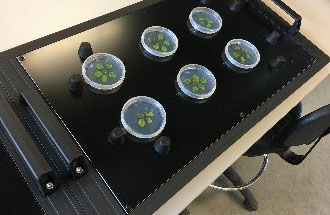Physiological phenotyping
Phenotyping for assessments of abiotic stress, diseases, pathogens, and pests
Phenotypes change as response to external factors such as stress and diseases. The external factors change biochemistry and physiology, and this translates into phenotypic features. Physiological phenotyping focuses on non-invasive measurements of such changes. This comprises using imaging technologies such as fluorescence and luminescence imaging, hyperspectral imaging, or NIR/IR imaging which can reveal biochemical changes in the surface proximity that are not detectable in visible light imaging. Moreover, it comprises imaging of symptomatic changes, e.g. wilting or occurrence of leaf spots or discolorations. In addition to measuring plant responses, imaging methods can be used to characterize the stress factors as such, e.g. insects feeding on plants and their movements or nematodes that colonize plant roots.
Image and data processing, particularly including artificial intelligence methods, establishes links between the measured signals and the biological properties of the samples. Applications comprise environmental stress assessments, plant pathological studies, or physiological characterization of plant varieties. Physiological phenotyping is important in plant research, for plant breeding, in climate change research, for plant health monitoring and testing, and in the development of plant treatments for improved cultivation.
click on image to enlarge
APPLICATION CASES
SOLUTIONS
We bought a LemnaTec LabScanalyzer (the predecessor of PhenoAIxpert) in July 2018. The instrument was delivered to us and installed remotely by a Lemnatec technician that instructed us about the use of the instrument. We were happy about the service: very good communication and excellent instrument set-up. The Lemnatec LabScanalyzer works nicely and is even more user-friendly than we expected. Almost no training of new users is needed. We hope to expand the uses of the instrument to obtain additional phenotyping options in the future, by interacting with LemnaTec.









